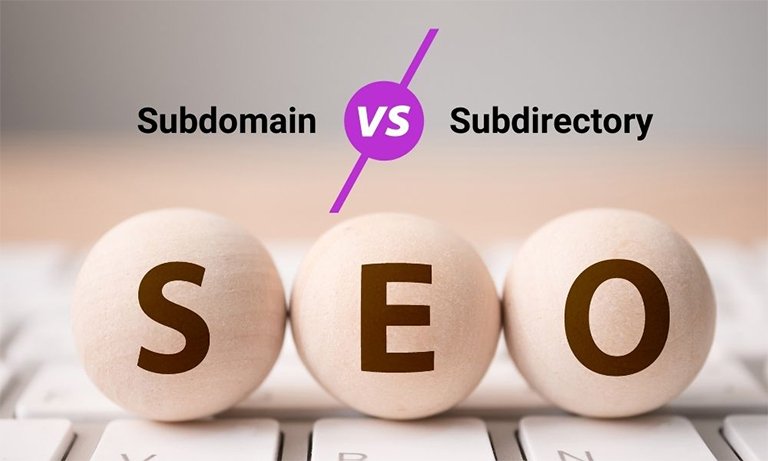When we talk about improving SEO for a website, one key factor many people overlook is how the content is structured across the site. Choosing between a subdomain and a subdirectory is not just a technical decision—it also affects how search engines view and rank your site. While both methods are valid, the impact they have on SEO can vary depending on your website goals, content strategy, and how your audience interacts with your content.

Now We will explain the difference between subdomains and subdirectories, their effect on SEO, and when it makes sense to use one over the other.
What Is a Subdomain?
A subdomain is a part of your main domain that acts as a separate section of your website. It is placed before the main domain name.
For example:
- blog.example.com
- store.example.com
Subdomains are often used when a business wants to create different sections that serve different purposes. For instance, a company might run its main site on “example.com” and have a knowledge base at “support.example.com.”
Search engines usually treat subdomains as separate websites. This means they are crawled, indexed, and ranked separately. While this setup offers more flexibility, it also creates challenges in SEO consistency and authority sharing.
What Is a Subdirectory?
A subdirectory (also called a subfolder) is a section within the main domain. Instead of having a separate web space, it organizes content within the same website.
For example:
- example.com/blog
- example.com/store
Using subdirectories means the content is seen as part of the main site. This helps with SEO because all link authority, domain strength, and traffic signals remain under one domain umbrella.
Main Difference Between Subdomains and Subdirectories
The key difference lies in how search engines treat them. A subdomain is treated like a separate website, while a subdirectory is seen as part of the main domain.
Here’s how they compare:
| Feature | Subdomain | Subdirectory |
|---|---|---|
| Treated as separate site | Yes | No |
| Shares domain authority | No (mostly) | Yes |
| Best for | Distinct content | Related content |
| Google Analytics tracking | Needs separate setup | Unified by default |
| Google Search Console | Needs separate property | One property |
| Link equity distribution | Limited | Full |
SEO Pros and Cons of Subdomains
Pros:
- Good for organizing very different types of content.
- Allows development of a unique brand or tone.
- Offers separation for different departments or regions.
Cons:
- Requires separate SEO efforts.
- Doesn’t benefit much from the root domain’s SEO power.
- Crawling and indexing may take more time.
SEO Pros and Cons of Subdirectories
Pros:
- Content benefits from the main domain’s authority.
- Easier to manage one SEO campaign.
- Google indexes and ranks it quickly as part of the main site.
Cons:
- Harder to separate entirely different topics or departments.
- Complex structures can become messy if not planned properly.
Real-World Examples and Case Studies
Several large companies have tested both structures. One popular case is HubSpot. Originally, their blog was on a subdomain (blog.hubspot.com). When they moved the blog to a subdirectory (hubspot.com/blog), they reportedly saw a rise in traffic.
This is not a guarantee that everyone will have the same results, but it shows that integrating content within the main domain can have SEO benefits due to shared authority and easier navigation.
What Google Says About It?
Google representatives, including John Mueller, have said that subdomains and subdirectories are treated equally if they are well optimized. However, in practice, websites using subdirectories often perform better because link equity, traffic signals, and authority are centralized.
That said, Google does require more crawling resources for subdomains. And in some cases, subdomains may not rank as easily without solid internal linking from the main site.
How Subdomains Impact Crawling and Indexing?
If your website uses a subdomain, Google may treat it like a new website.
This means it needs:
- Its own XML sitemap
- Internal links from the main domain
- A separate Search Console property
Without proper linking and configuration, the subdomain may take longer to get crawled and indexed. This delay can result in slower content discovery and weaker search visibility.
When Should You Use a Subdomain?
Use a subdomain when:
- The content is very different from your main site (e.g., an e-learning platform vs. a business site).
- You have different development teams or server setups.
- You want to target different regions or languages with unique branding.
- You plan to run experiments or test new features.
When Should You Use a Subdirectory?
Use a subdirectory when:
- The content is related and complements your main domain.
- You want to build domain authority under one roof.
- Your SEO strategy focuses on growing the main site’s traffic.
- You want easier tracking and management with Google Analytics and GSC.
Technical SEO Considerations
When choosing between subdomains and subdirectories, also consider:
- Canonical Tags: Help avoid duplicate content by identifying the primary URL.
- Site Architecture: Maintain clear, logical hierarchy regardless of choice.
- Internal Linking: Strengthen your SEO by linking subdomains to the root site if used.
- Crawl Budget: Google allocates a separate crawl budget per subdomain, so inefficient structure can cause delays.
How Search Engines Handle Authority?
Search engines like Google calculate authority based on signals like backlinks, content relevance, and site engagement. Subdirectories inherit authority directly from the main domain. Subdomains, unless well-linked, often have to build their own reputation from scratch.
That’s why marketers working on content marketing, blogs, or SEO campaigns prefer subdirectories when possible. It strengthens the core domain rather than splitting value across two properties.
What About Multilingual or Regional Sites?
If you are targeting different languages or countries, both structures can work:
- Subdirectories:
example.com/fr/,example.com/ar/ - Subdomains:
fr.example.com,ar.example.com
However, subdirectories are easier to manage under one domain with consistent SEO and tracking.
Final Recommendation
If your content is closely related to your main site and supports your overall SEO strategy, go with subdirectories. They are easier to manage, help consolidate authority, and speed up results.
Use subdomains only when your content needs to be separate due to technical, branding, or management reasons.
If you go this route, make sure you:
- Link the subdomain clearly from the main site.
- Submit a separate sitemap.
- Monitor the subdomain performance through separate tools.
Conclusion
Both subdomains and subdirectories have their own place in web development and SEO. There is no universal rule that applies to every site. However, from an SEO perspective, subdirectories generally offer better performance because they contribute to the strength of the main domain.
When planning your site structure, focus on long-term SEO benefits, not just technical convenience. A well-thought-out structure can significantly influence how your site performs in search engine rankings and how users experience your content.
Make your decision based on your business model, content goals, and how you want to grow your online presence.











